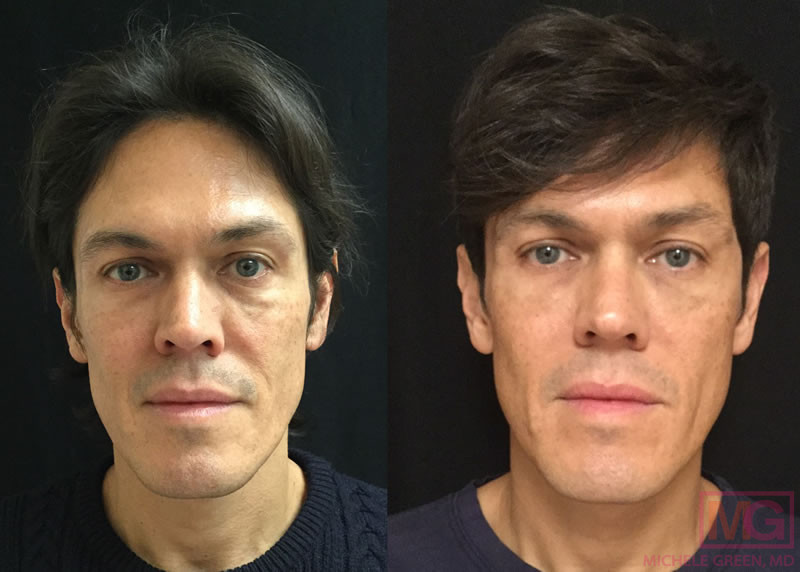Best Cheek Fillers
Cheek fillers are among the most popular non-invasive cosmetic procedures performed at Dr. Michele Green’s New York City dermatology office. When fillers are injected into the cheeks, they increase or replenish cheek volume, enhance the definition of bone structure, stimulate new collagen production, and eliminate other signs of aging. Over time, the cheek area can appear hollow or wrinkled due to the loss of collagen and volume. Collagen is a vital structural component in the skin, providing a foundation for a supple, firm, and youthful-looking complexion while also helping to diminish fine lines and wrinkles. Cheek filler treatments are among the most highly sought-after cosmetic procedures for achieving facial rejuvenation for patients who prefer non-invasive options to plastic surgery.
The most popular dermal fillers for cheek augmentation are made from hyaluronic acid (HA), such as Juvederm and Restylane. Hyaluronic acid fillers provide immediate, natural-looking results with few potential side effects. Another common dermal filler, Sculptra, which is composed of poly-L-lactic acid, stimulates collagen to improve the appearance of the midface. Due to their non-invasive nature, cheek fillers can be easily combined with other non-surgical cosmetic procedures to address multiple signs of aging in a single appointment. Dr. Green utilizes various types of fillers, including Juvederm, Restylane, and Sculptra, to provide her patients with customized treatment plans that yield optimal facial rejuvenation results and a natural-looking youthfulness.
Dr. Michele Green is an internationally renowned board-certified dermatologist with over two and a half decades of experience providing some of the best non-invasive cosmetic procedures, including dermal fillers. Regarding facial rejuvenation, Dr. Green takes a holistic approach and embraces a less-is-more philosophy, customizing each patient’s treatment plan to address their specific skin concerns and desired outcomes. She is consistently recognized as one of New York’s best physicians by Castle Connolly, Super Doctors, and New York Magazine, due to her dedication to her patients and expertise. When you consult with Dr. Green about cheek fillers at her private dermatology office in Manhattan’s Upper East Side neighborhood, she will collaborate with you to create a personalized plan for achieving natural-looking, long-lasting, beautiful cosmetic results.
What are cheek fillers?
Facial fillers are injectable products used to enhance facial contours, augment specific features, replenish lost volume, and provide a more youthful appearance. Cheek fillers are injected into the midface and cheek area to increase volume, enhance the appearance of the cheekbones, and eliminate signs of aging, such as marionette lines, nasolabial folds, and other fine facial lines. Each filler has a unique composition suited for different augmentations. The components of the fillers include Hyaluronic Acid, poly-L-lactic acid, and Calcium hydroxylapatite. An expert injector, such as Dr. Michele Green in NYC, will select the best cheek fillers for your facial rejuvenation plan, considering your facial anatomy, specific skin concerns, and personal aesthetic goals. This creates a completely customizable approach and provides long-lasting, natural-looking results.
What does cheek filler do?
Cheek fillers are used to restore facial volume, enhance the definition of the bone structure, provide a lifting effect to the midface, reduce fine lines, and create a more youthful overall appearance. Loss of volume in the midface and cheek area is often one of the first signs of aging, resulting in a tired, gaunt look. These fillers can diminish these signs of aging by plumping the skin from within, increasing the amount of hyaluronic acid, and stimulating the production of new collagen in targeted areas. Hyaluronic acid is a naturally occurring substance that essential hydrating properties for the skin, contributing to its plumpness, suppleness, and smoothness. Collagen is a prevalent skin protein that provides elasticity and firmness, acting as structural support to prevent the skin from becoming loose, saggy, and wrinkled. By boosting the levels of hyaluronic acid and collagen in the skin, cheek fillers can restore a youthful, natural-looking appearance without the need for plastic surgery or downtime.
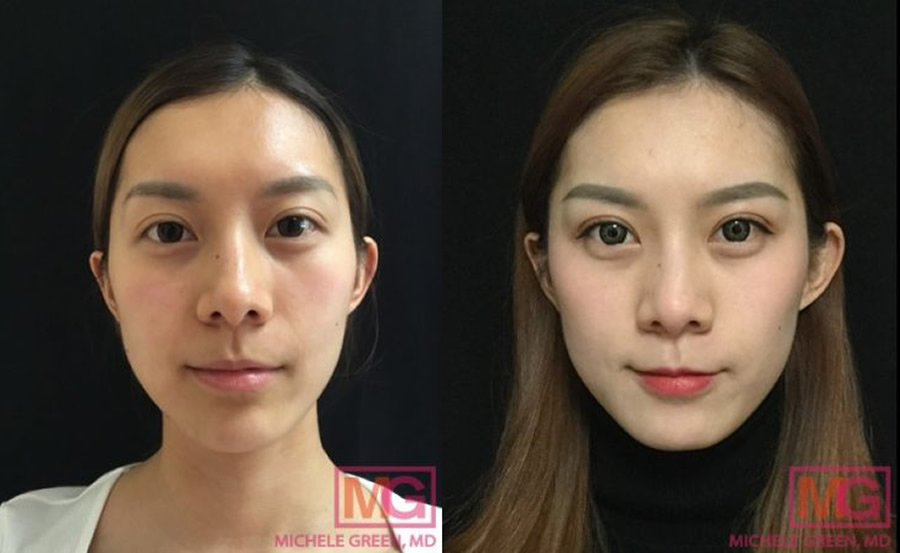
Sculptra 3 months before and after
What types of fillers are used in the cheeks?
Several types of dermal fillers can enhance the appearance of the cheeks. Many patients ask, “What is the Best Cheek Filler?” Each filler has unique uses for the cheeks, making it impossible to determine which one is better. At Dr. Green’s private dermatology office, various types of fillers are used for cheek augmentation. Dr. Green considers each patient’s specific needs and aesthetic goals to decide which dermal fillers to incorporate into their treatment plan. The most popular cheek fillers include:
- Juvederm Voluma – Juvederm Voluma is a hyaluronic acid filler produced by the cosmetic company Allergan. It is one of the most popular dermal fillers due to its ability to enhance facial contouring, lift the cheeks, improve facial sagging, and diminish the appearance of jowls and hollowness in the face. Formulated with patented Vycross technology, the filler integrates smoothly into the cheeks, allowing for fuller cheeks with natural movement. In addition to cheek augmentation, Juvederm Voluma received FDA approval in 2020 for the enhancement of the chin and jawline.
- Restylane Lyft – Restylane Lyft is a hyaluronic acid-based dermal filler developed by the pharmaceutical company Galderma. The product received FDA approval in 2015 for restoring age-related volume loss in the midface. Restylane Lyft is the thickest dermal filler in the Restylane family of hyaluronic acid fillers, making it ideal for enhancing bone structure, correcting volume loss, and providing a lifting effect in the cheek area. Dr. Green also uses Restylane Lyft to reduce fine lines and improve chin and jawline augmentation, as this filler has a unique lifting ability often necessary to rejuvenate the lower face.
- Sculptra – Sculptra is a unique, long-lasting dermal filler made from poly-L-lactic acid, which stimulates new collagen production in the treatment areas, leading to a gradual, natural-looking enhancement. Originally developed to restore facial volume in patients living with HIV, the facial rejuvenation results were so remarkable that Sculptra received FDA approval for cosmetic purposes soon after. Typically, a short series of three Sculptra treatments is required. It takes 4 to 6 weeks to notice the effects of each Sculptra treatment, and results can last up to two years. Most patients undergo regular follow-up treatment sessions to maintain optimal results. In addition to correcting volume loss in the midface, Sculptra is an excellent option for reducing the appearance of acne scars and achieving non-surgical body contouring.
- Restylane Contour – Restylane Contour received FDA approval for cheek augmentation in June 2021. It is formulated with Galderma’s proprietary XpresHAn technology, which enables dynamic movement. This technology makes Restylane Contour especially suitable for rejuvenating the mid-face and cheek area, as the flexibility of the dermal filler offers incredibly natural-looking cheek enhancement.
- Radiesse —Radiesse is a dermal filler composed of Calcium hydroxylapatite (CaHA) microspheres. It immediately stimulates new collagen production upon injection, resulting in a smoother skin texture and restored volume. Additionally, when the microsphere-containing CaHA gel is injected, healthy, new skin cells grow around the microspheres, resulting in volume enhancement. Radiesse produces long-lasting results, with effects that can remain visible for almost two years following the dermal filler treatment.
- SkinVive —Juvederm’s newest FDA-approved dermal filler, SkinVive, is designed to enhance skin smoothness and hydration for the cheeks. Like other Juvederm fillers, SkinVive is an injectable gel made of hyaluronic acid. However, due to its unique formulation, SkinVive stands apart from other dermal fillers by improving hydration and smoothness in the area surrounding the injection site. Patients report that their skin remains smooth and glowing for up to six months after treatment.
Consulting an experienced injector, such as board-certified dermatologist Dr. Michele Green, for cheek fillers is critical. Expertise in injection technique, the properties of various dermal filler products, and facial anatomy is essential to ensuring that your cheek filler treatment is safe, effective, and yields optimal facial rejuvenation results. Dr. Green is an internationally renowned cosmetic dermatologist and expert injector who performs precise, customized dermal filler treatments tailored to each patient’s needs, ensuring the most stunning results while prioritizing patient safety and satisfaction.
Who is a good candidate for cheek filler injections?
A good candidate for cheek fillers is a person who is at least 21 years old, in overall good health, and seeking cosmetic enhancement of the midface and cheek area. This individual should not have an allergy to any filler component and must not be pregnant or breastfeeding. A good candidate has realistic expectations regarding the facial rejuvenation results achievable with dermal filler injections. Cheek filler treatment is a cosmetic procedure suitable for individuals looking to enhance their bone structure definition, add or replenish cheek volume, or reduce other signs of aging, such as fine lines. You may not qualify for cheek filler treatment if you have a bleeding disorder or a history of allergic reactions to dermal filler products. During your initial cheek filler consultation with Dr. Green at her private dermatology office in NYC, she will gather a thorough medical history and review your aesthetic goals to determine the most appropriate treatment plan for you.
What is the process of cheek filler treatment?
Cheek filler treatment begins with a consultation with an expert dermatologist, such as Dr. Michele Green, in New York City. During your consultation, you will have the opportunity to discuss your specific concerns and ideal aesthetic results. Photos of the treatment area will be taken for your private medical record to enhance your discussion and track future progress. Dr. Green will collect a thorough medical history, review any previous cosmetic procedures you may have had, and physically assess the cheek area and midface. If you are a good candidate for cheek filler treatment, Dr. Green will work with you to develop a timeline for your dermal filler injections. The filler injections can be performed on the same day as the consultation, or you can schedule them for a later date, depending on your availability and preference.
On the day of your cheek filler treatment, a topical numbing cream should be applied to the midface and cheek area one hour before your injections. Once you arrive at Dr. Green’s dermatology office for your cheek fillers, the numbing cream will be removed, and the skin will be sterilized. Most dermal fillers contain a numbing agent, in addition to the topical numbing, making the procedure virtually pain-free. Dr. Green will artfully perform the cheek filler injections according to your treatment plan. Ice packs will be applied to the injection sites immediately after the dermal filler injections to minimize side effects like bruising and swelling. Dr. Green often has her patients return in two weeks to reevaluate the results and determine if a touch-up is needed.
What are the side effects of dermal fillers?
Generally, there is little downtime associated with cheek fillers. The majority of patients return to work or home immediately after the injection. Some of the most common side effects include:
- Bruising
- Redness
- Swelling
- Discoloration
- Tyndall effect
- Irritation
- Lumps or bumps
- Pruritus
- Tenderness
Rare but serious side effects from dermal filler treatment include allergic reactions and superficial necrosis at the treatment site. Unintentionally injecting filler into a blood vessel can also lead to serious complications, including blindness. To ensure that your cheek filler is safe and effective, it is essential to consult with a board-certified dermatologist, such as expert injector Dr. Green.
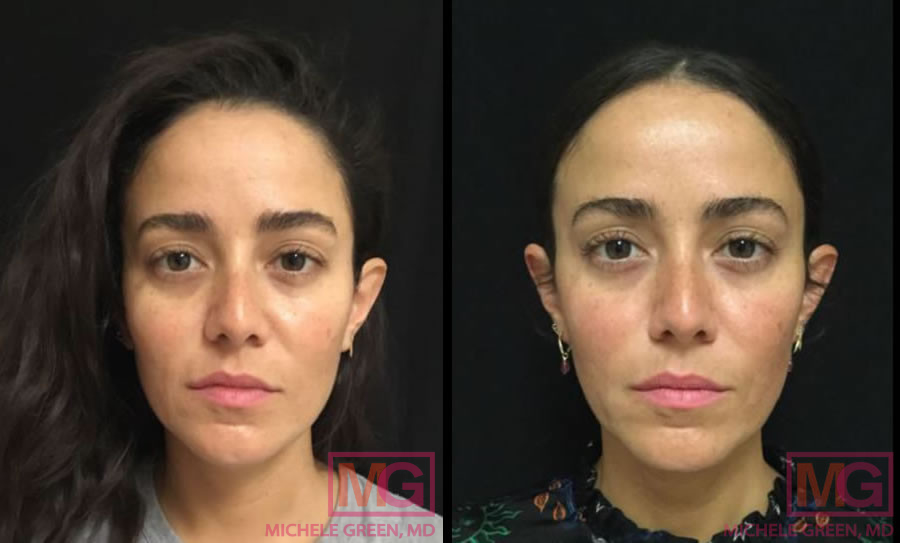
Frequently Asked Questions (FAQs) for Cheek Fillers
Where is cheek filler injected in the face?
Cheek filler is often injected into multiple spots along the cheekbones. The exact location of the filler injections varies depending on the type of filler used and the patient’s aesthetic goals. Fillers injected to improve volume are typically placed deep against the bone for the most natural results. Meanwhile, fillers like SkinVive are injected superficially to hydrate the skin cells. Ultimately, during your initial consultation with Dr. Green, she will review your aesthetic goals and her treatment plan. She will explain further where she will inject the cheek filler to meet your individualized needs.
What to expect after cheek fillers
When you receive cheek filler from an expert injector like Dr. Green, the injection procedure is quick and painless. Before the treatment, Dr. Green will review all necessary aftercare instructions. Some patients may experience mild side effects after the injections. The most common side effects of cheek filler treatment are mild swelling and bruising at or near the injection sites. Swelling in these areas may resemble small lumps or bumps. Should any such bumps be observed after your dermal filler injections, there is no cause for concern, as they should resolve on their own within 1-2 weeks as the filler settles. Other possible side effects may include bruising of the treatment area, redness, and soreness. In many cases, ice can be used to reduce swelling or bruising. Additionally, patients prone to bruising can take Arnica, a herbal supplement that decreases bruising. Patients will also be instructed to discontinue blood-thinning medications and supplements for a few days before and after the filler treatment to minimize swelling and bruising. Depending on the type of filler used, facial rejuvenation results may be observable immediately after the injections (such as with hyaluronic acid fillers) or may take longer to develop (as with Sculptra). If you have any questions or concerns after receiving cheek filler treatment from Dr. Green, please do not hesitate to contact our office.
How long do cheek fillers take to settle?
While they may notice some results immediately, cheek fillers typically require two weeks to settle fully, allowing the final results to become completely visible. When dermal filler “settles,” it integrates with the skin tissue in the treatment area, making the cosmetic procedure’s final effects fully apparent. During the two weeks it takes for the dermal filler to settle, patients may experience mild side effects, such as swelling, redness, and bruising at or near the injection sites. However, these side effects usually resolve within one to two weeks of the filler treatment.
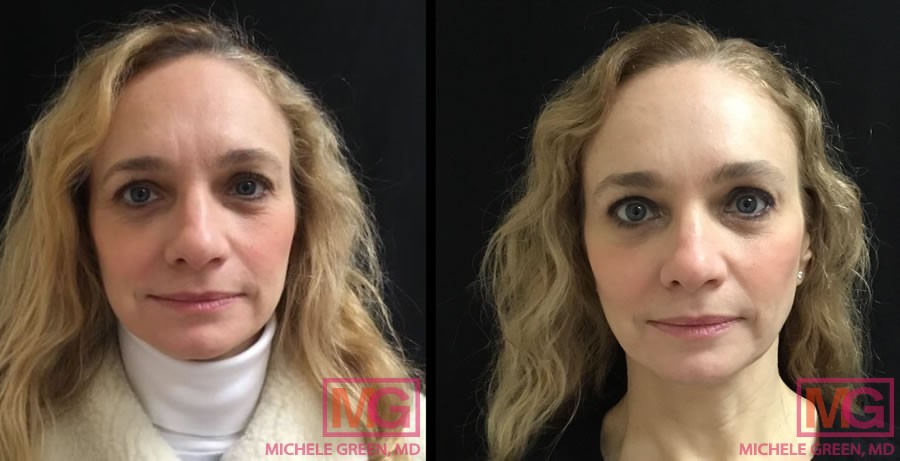
How long do cheek fillers last?
On average, cheek fillers produce facial rejuvenation results that last between six months and one year. The type of fillers used plays the biggest role in determining the longevity of the results. Additionally, the amount of filler used for your cheek augmentation also impacts the longevity of the results. When you receive filler from a skilled injector, they will be able to set expectations for you. Most patients who undergo hyaluronic acid cheek filler treatments, such as Juvederm or Restylane, receive maintenance injections semiannually or annually to maintain consistent results. Sculptra is a dermal filler product with results lasting up to two years. Although Sculptra is longer-lasting, many patients will have annual maintenance treatments, as Sculptra is a collagen stimulator that produces gradual facial rejuvenation results. When you consult with board-certified dermatologist Dr. Michele Green at her private NYC office, she will help you establish a schedule for cheek filler treatment sessions that suits your particular needs and goals.
What to do after cheek fillers are injected?
After receiving cheek filler treatment from Dr. Green, patients are provided with aftercare instructions for optimal results. The specific aftercare guidelines may vary depending on the type of dermal filler used for cheek augmentation. Hyaluronic acid dermal filler injections have slightly different aftercare than fillers made from other substances, such as poly-L-lactic acid (Sculptra). For example, treatment areas injected with Sculptra require massaging several times a day for a few days. Massaging Sculptra ensures even product distribution and promotes collagen production throughout the treatment area. In contrast, hyaluronic acid cheek fillers do not necessitate massaging for optimal results.
After receiving any cheek filler, you should refrain from applying makeup around the injection sites for at least 24 hours, avoid strenuous exercise for 48 hours, abstain from alcohol consumption for several days, and discontinue blood-thinning medications or supplements for several days. Applying makeup or touching the area can increase the risk of infection, while exercise, alcohol consumption, and blood-thinning medications can elevate the likelihood of bruising. Dr. Green will provide all the necessary aftercare information required for achieving and maintaining ideal cosmetic results, based on the specific type of filler used. In addition to following the aftercare protocol, Dr. Green may ask you to return two weeks after your initial cheek filler treatment to evaluate the results and determine if any touch-up is needed.
Can you use skincare and makeup after cheek fillers?
While you can return to most of your regularly scheduled activities immediately after filler treatment, Dr. Green recommends waiting several hours before applying makeup or other skincare products, such as lotion or sunscreen. To reduce the risk of infection, it is important to keep the skin clear and dry after cheek filler treatment. Because fillers are injectable treatments that penetrate the skin, applying products may introduce bacteria into the injection sites, potentially leading to infection. An infected injection site will be red, inflamed, and painful. If you believe your injection site has become infected, inform your medical provider immediately, as you may need to start antibiotics.
How to sleep after cheek fillers
After dermal filler treatment, it is essential to avoid applying pressure directly to the treatment area. Rubbing or massaging the injection site can increase the risk of hyaluronic acid filler migration, potentially diminishing the treatment’s effectiveness and leading to more serious side effects. Therefore, Dr. Green recommends sleeping on your back in the days following the cheek filler treatment to prevent excessive pressure on the cheek area while you sleep. Sleeping on your side puts more pressure on the cheeks, increasing the risk of filler migration and making your results appear uneven.
How many syringes do you need for cheek fillers?
Patients typically receive between 2 and 4 syringes, approximately 1-2 mL per cheek, of dermal fillers to achieve their desired cheek appearance. The amount of cheek filler necessary for each patient will vary based on their face shape, the type and severity of the skin concerns being addressed, their aesthetic goals, and the specific type of filler used. During your initial facial rejuvenation consultation with Dr. Green, she will physically assess the treatment area and determine the appropriate type of filler as well as an approximate amount of cheek filler needed to meet your goals. Cheek filler treatment is temporary, and most patients require maintenance injections of dermal filler to achieve the best results.
How long does filler last in the cheeks?
While the longevity of your cheek fillers varies depending on the type and amount of filler used in your treatment, as well as your individual metabolism, it is recommended that you maintain your cosmetic results with regular filler appointments. On average, dermal fillers last in the cheeks for approximately 9 months, so most patients undergo a “touch-up” treatment every 6-12 months to sustain optimal facial rejuvenation results. These maintenance appointments are also beneficial for Dr. Green to reevaluate your face and make any necessary adjustments to your treatment as your needs and goals evolve over time.
Do cheek fillers help nasolabial folds?
Nasolabial folds, also known as laugh lines or smile lines, are the wrinkles that extend from the side of the nose down to the corners of your mouth. Deep nasolabial folds may be genetic or develop due to decreased collagen and elastin production with age, which causes the skin to lose its structure and for wrinkles to become etched into the skin. Fortunately, dermal fillers can reduce the appearance of nasolabial folds. In fact, nasolabial folds are one of the most common signs of aging treated with dermal filler injections. Cheek fillers can help improve nasolabial folds; however, for optimal results, Dr. Green often pairs cheek fillers with fillers injected directly into the nasolabial folds.
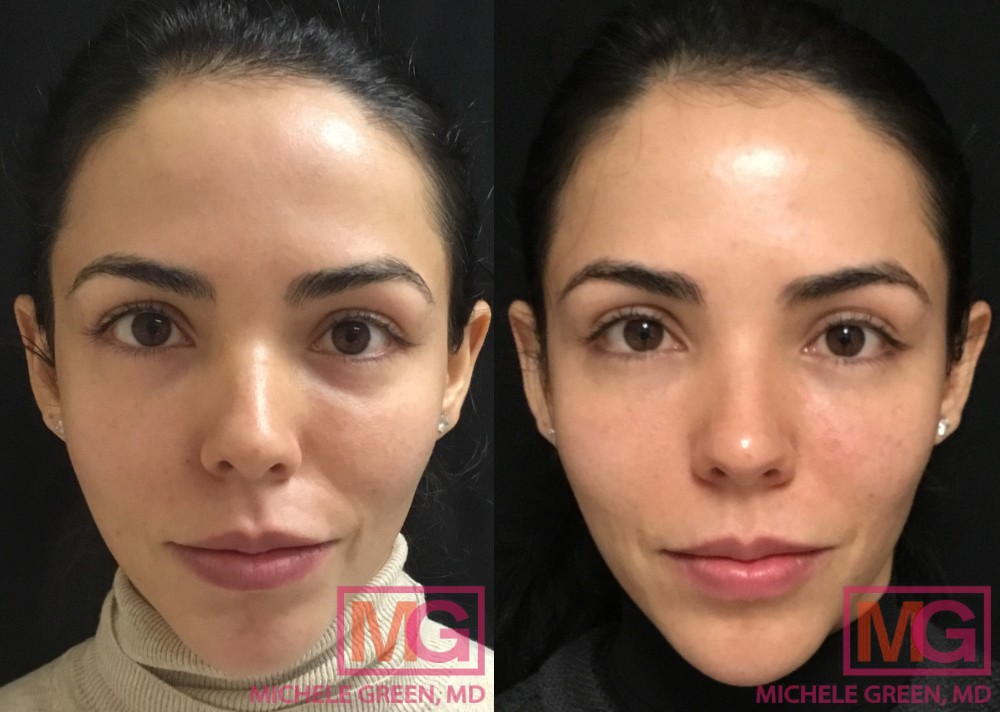
Do cheek fillers lift your face?
Cheek fillers lift the midface and replenish cheek volume, creating a more youthful appearance. By restoring lost volume, fillers can enhance sagging skin around the mid and lower face. Cheek fillers also improve the definition of the bone structure and provide a smoother skin texture. While the facial rejuvenation effects of cheek filler treatment may not be as dramatic as those of a surgical facelift, patients appreciate that their cheek fillers are customizable, adaptable to their evolving aesthetic preferences over time, and require little to no recovery time. When you consult with Dr. Green regarding cheek enhancement, you can discuss your personal aesthetic goals, and she will inform you whether cheek filler treatment will provide the lift you desire or whether another cosmetic procedure would be better suited to achieve the facial rejuvenation results you seek.
Combining cheek fillers with other non-invasive cosmetic procedures
Dermal fillers are an excellent option for enhancing facial contours, augmenting specific features, replenishing volume loss, and providing a more youthful appearance. As a non-invasive cosmetic procedure, dermal fillers are a popular alternative to plastic surgery due to their consistently stunning results, minimal downtime, and ease of administration. Dermal filler injections can easily be combined with other non-invasive cosmetic treatments to achieve a non-surgical facelift. Many patients seeking cheek enhancement may exhibit other signs of aging, such as dynamic fine lines, pigmentation issues, skin laxity, or sun damage. Dr. Michele Green offers a variety of non-invasive cosmetic procedures at her private dermatology office. She will collaborate with you to develop a personalized treatment plan tailored to your specific cosmetic concerns. The most common procedures that accompany fillers include Botox injections, Fraxel, and Thermage treatments.
Botox is the gold standard for preventing and eliminating dynamic wrinkles. Dynamic fine lines are those that form over time due to repetitive facial expressions, most commonly affecting the skin of the upper face, glabella (the area between the brows), forehead, and crow’s feet. Botox can also be used to slim the face and treat temporomandibular joint (TMJ) pain. Botox is an injectable neurotoxin that ‘freezes’ targeted facial muscles, preventing their contraction and resulting in smoother skin texture. The effects of Botox typically take up to two weeks to appear and last for up to four months. Most patients receive Botox injections every 3-4 months to maintain optimal results. Dr. Green is an Allergan platinum injector, providing what has been described as the “best Botox injections in New York.” Many patients undergo Botox and dermal filler injections during the same appointment to address age-related and dynamic fine lines, as well as volume loss in their cheeks.
Fraxel is a skin resurfacing laser treatment often referred to as the ‘magic eraser’ by Dr. Green for its unique ability to target a wide range of skin concerns. The Fraxel Dual laser used by Dr. Green operates on two distinct wavelengths of light to treat a myriad of skin concerns. The 1550 nm setting treats fine lines, wrinkles, and acne scars, while the 1927 nm setting effectively targets sun damage and pigmentation. Fraxel relies on fractional laser technology to stimulate new collagen production in the treatment areas, thereby improving skin texture and tone. Since the skin’s surface is left intact, minimal downtime is involved, with most patients experiencing mild side effects, such as swelling, redness, and tenderness in the treatment area, for approximately two days. Most patients require three treatment sessions, each spaced one month apart, to achieve optimal facial rejuvenation results with Fraxel.
Thermage is the gold standard for non-invasive skin tightening. This treatment utilizes radiofrequency energy to stimulate the production of new collagen, resulting in smoother, firmer, and tighter skin. There is no downtime involved with Thermage, meaning patients can resume their normal daily activities immediately after the procedure is complete. In addition to treating the midface, Thermage can improve skin elasticity in the lower face, neck, chest, décolletage, upper arms, abdomen, thighs, and buttocks. The effects of Thermage last up to two years, with most patients undergoing annual maintenance treatments to maintain optimal results.
Are dermal cheek fillers safe?
Yes! Cheek fillers are a safe and effective non-surgical cosmetic procedure for facial rejuvenation when dermal filler injections are performed in a medical setting by an expert dermatologist, such as Dr. Michele Green, in New York City. The dermal filler treatment process is straightforward for an experienced and knowledgeable injector like Dr. Green. The risk of encountering unwanted side effects or poor cosmetic results increases when receiving filler treatment in a medical spa setting or elsewhere outside the office of a board-certified dermatologist or plastic surgeon. A thorough anatomical understanding is essential, as serious side effects, such as injection into a blood vessel, can occur otherwise. Dr. Green is a board-certified dermatologist with over 25 years of experience providing her patients with the best non-surgical cosmetic procedures for beautiful, natural-looking, long-lasting facial rejuvenation results. When you choose to work with an expert injector like Dr. Green, you ensure that your dermal filler treatment prioritizes patient safety and satisfaction.
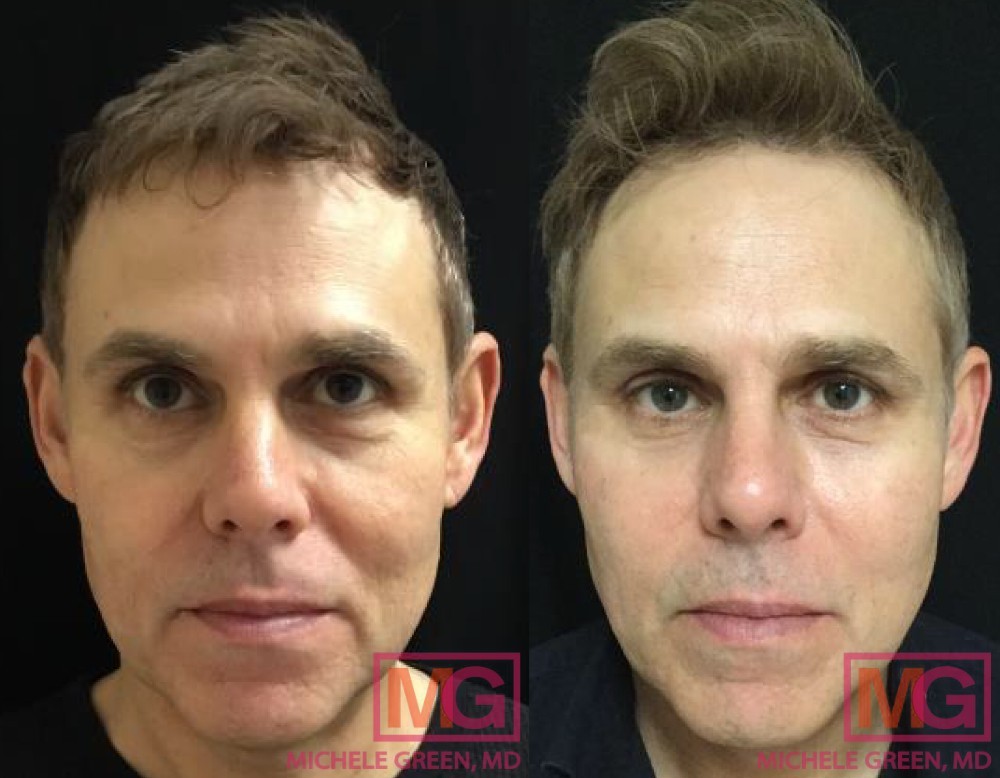
Are cheek fillers dangerous?
Overall, treatment with cheek fillers is a very safe procedure for most people. However, you should not get filler if you are pregnant, breastfeeding, or allergic to any ingredients. As such, sharing your complete medical history with your injector is important. When you have dermal filler treatment with an experienced board-certified dermatologist, such as Dr. Green in NYC, the procedure is a safe and effective option for non-surgical rejuvenation. Having dermal fillers with an expert injector significantly reduces the risk of encountering adverse events and unwanted side effects. The most common side effects of cheek fillers include mild swelling, bruising, and tenderness at or near the injection sites, which typically resolve on their own shortly after the injections. More serious side effects can occur when an inexperienced or unqualified injector performs cheek filler treatment. For example, the inadvertent injection of dermal filler into a blood vessel can cause side effects such as blindness, stroke, and necrosis of skin tissue.
How to reduce swelling and bruising after cheek filler treatment
One of the most effective ways to reduce swelling after dermal filler injections is to apply an ice pack directly to the treatment area immediately after the cosmetic procedure. When you have cheek filler treatment with Dr. Green at her private dermatology office in Manhattan’s Upper East Side neighborhood, ice packs will be applied immediately following the injections to minimize initial swelling. A cold compress can be used intermittently after the filler treatment, as the patient desires, for their comfort. Strenuous exercise should be avoided for at least 48 hours following cheek filler treatment, as increasing one’s body temperature can worsen swelling near the injection sites and increase the risk of infection.
Dr. Green recommends that patients avoid blood-thinning medications and supplements such as Ibuprofen, aspirin, and vitamin E in the days leading up to and following their cheek filler treatment. Blood thinners may worsen the potential side effects of swelling and bruising. Arnika Forte is an herbal supplement that can be used topically or orally to help further prevent bruising and swelling. It is available at Dr. Green’s dermatology office or can be purchased over the counter at your local pharmacy.
Where to inject cheek fillers?
Cheek fillers are typically injected into specific areas of the midface to enhance volume, contour, and lift the face. The exact placement and depth of injection depend on the patient’s facial anatomy and desired results. Treatment should always be performed by a board-certified dermatologist, such as Dr. Green, to ensure safety and optimal aesthetic outcomes. When Dr. Green performs your cheek filler, you can be confident that she will inject the filler to provide you with the results you desire.
Does cheek filler migrate?
Filler migration is an exceptionally rare side effect in any case of dermal filler injections. Cheek filler, in particular, is less likely to migrate than dermal fillers placed in areas of the face such as the lips and under-eyes. Dermal filler migration is most likely to occur when an inexperienced or unqualified injector performs the injections. Using too much dermal filler product or an inappropriate injection technique may result in dermal filler migration. For this reason, it is essential that your dermal filler injections are performed by a board-certified dermatologist who possesses both the experience and expertise necessary to achieve optimal results, such as Dr. Green in New York.
If you’ve had hyaluronic acid fillers that have migrated, resulting in asymmetry, nodules, or another poor cosmetic result, Dr. Green can dissolve the dermal filler product with hyaluronidase injections. Hyaluronidase is an enzyme that breaks down hyaluronic acid and can be used to reverse the effects of HA filler treatment. Sometimes, more than one session of hyaluronidase injections may be required, depending on the amount of dermal filler initially injected (more dermal filler product needs a greater amount of hyaluronidase to dissolve fully).
Can cheek filler migrate to the under-eye area?
In the rare case where cheek filler migrates, it can relocate to multiple areas of the face, including the under-eye area. Overfilling or incorrect technique may result in dermal filler migration. To minimize risks, it is recommended that you receive filler from a board-certified plastic surgeon or dermatologist, such as Dr. Michele Green in New York.
Do cheek fillers hurt?
No, the process of receiving dermal filler injections is quick and relatively painless. The injectable fillers used by Dr. Green at her private dermatology office in NYC are compounded with lidocaine, a local anesthetic, to enhance patient comfort during the treatment. Additionally, Dr. Green prescribes a topical numbing cream for patients to apply to the entire treatment area one hour before the injections. Once you arrive at Dr. Green’s office on the Upper East Side, the numbing cream will be removed and the skin sterilized in preparation for the treatment.
How much is cheek filler?
Cheek augmentation with dermal filler can vary significantly in price, depending on several contributing factors. The total cost of your cheek filler treatment will be affected by the amount of dermal filler product required and the type of filler chosen. Other factors influencing the total cost include the geographic location of the medical office where you receive treatment and the experience level of your injector. When you work with Dr. Green, she will design a custom facial rejuvenation treatment plan that balances your budget with your desired cheek augmentation outcome. After your initial consultation, Dr. Green’s office will provide you with a more accurate estimate of the treatment cost based on your personalized treatment plan.
Why do people get cheek fillers?
People get cheek fillers for various reasons. The most common reason is that they struggle with midface hollowing and volume loss and desire more pronounced cheeks without downtime. As we age, our skin naturally loses collagen, resulting in sagging and wrinkles. A quick, non-invasive solution is cheek fillers.
What do cheek fillers look like?
When an expert injector like Dr. Green performs your cheek filler treatment, the result is firmer, smoother skin texture and a subtle, youthful fullness. Cosmetic enhancement with dermal fillers should not be obvious or overdone. It should be difficult to tell if someone has cheek fillers unless you are a professional injector. If the dermal filler injections are poorly performed, patients may observe facial asymmetry, persistent puffiness or swelling, overfilling, or an unnatural appearance.
Should I get cheek fillers?
Cheek filler treatment is an amazing cosmetic procedure that can reduce fine lines, enhance bone structure, and restore volume to the midface area. Dr. Green can assist you in creating a personalized facial rejuvenation treatment plan tailored to your unique facial structure and cosmetic goals. If you decide to undergo cheek filler treatment, Dr. Green offers several different filler products to ensure you achieve the most natural-looking, long-lasting, and optimal results. There are minimal side effects associated with cheek filler treatment, and there is no downtime. If you are uncertain about whether you should get cheek fillers, schedule a consultation with Dr. Green, an expert injector who can recommend the combination of treatments that will benefit you the most, so you’ll look and feel like the best version of yourself.
How do I get started with cheek fillers today?
Cheek fillers are among the most popular cosmetic procedures due to their ability to correct age-related volume loss, enhance facial contours, and provide a more youthful appearance. With numerous options for cheek fillers, starting the process can be overwhelming. The first step is to meet with an expert injector who can select the best cheek filler to suit your facial anatomy and aesthetic goals. Many dermal fillers can be used for cheek augmentation, each with a unique composition and skin benefits. This allows for a completely customizable approach and long-lasting, natural-looking results. An experienced injector, such as Dr. Michele Green in NYC, will use an individualized approach, evaluating your facial anatomy and discussing your aesthetic goals before selecting the right filler for your needs.
Dr. Michele Green is an internationally renowned board-certified dermatologist with over two and a half decades of experience providing some of the globe’s most discerning individuals with the best non-invasive cosmetic procedures, including cheek fillers. Dr. Green takes a holistic approach and adopts a less-is-more philosophy regarding cosmetic procedures, tailoring each patient’s treatment plan to best suit their specific skin concerns and aesthetic goals. She is consistently recognized as one of New York’s top physicians by Super Doctors, Castle Connolly, and New York Magazine for her dedication to her patients and expertise. To begin your non-invasive facial rejuvenation journey and learn more about cheek filler treatment, schedule a consultation with Dr. Green by contacting us online or calling the office at 212-535-3088.
 212-535-3088
212-535-3088 